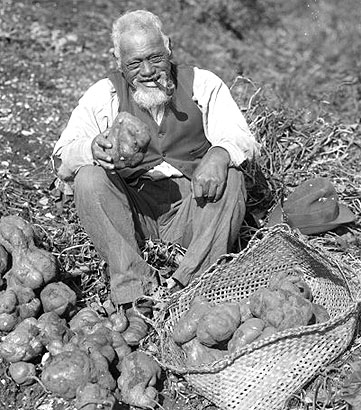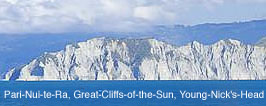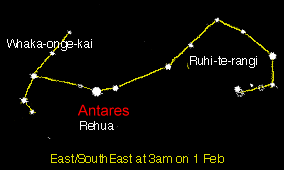 Maori
Songs
- Kiwi Songs - Home
Maori
Songs
- Kiwi Songs - Home
This famous oriori from the East Coast is of pre-European origin.
The kumara or sweet potato was a treasured food, an essential
item at feasts and on other important occasions. Elaborate
ritual usages were observed during its cultivation, and various
myths explained its origin and nature.
This oriori introduces a child to a dozen myths and historical
stories that he will later learn in full.
It is sung here by Turau Te Tomo (1896-1965) and Marata Te Tomo
(1900-1982), who recorded it in 1962.
|
Po!
Po ! |
Baby! Potiki!1
|
|
This is an oriori, to soothe a baby. He is first introduced to a magical bird that was a guardian of the people, and told of an ancestor's journey on that bird (or on a high-speed voyaging waka) across the oceans to obtain the seed kumara. |
|
| Ka
noho Uru, ka noho
i a Ngangana; Puta mai ki waho ra ko Te Aotu, ko Te Aohore, ko Hine-tua-hoanga, Te Whatu o Poutini ei! |
Uru
lived with Ngangana,6
|
|
Potiki is now introduced to the pounamu rock and the sandstone maiden (sandstone was used to shape pounamu). Another story tells of how Ngahue fled Hawaiki with his pet fish called Poutini, escaping to the West Coast where Ngahue found a safe place in the Arahura River for Poutini to live in peace. |
|
| Kei
te kukunetanga mai o Hawaiki Ko te ahua ia Ko Maui-wharekino ka noho i a Pani, Ka kawea ki te wai o Monariki Ma Onehunga, ma Onerere, Ma te piere, ma te matata Te pia tangi wharau, ka hoake Ki runga ra, te Pipi-wharauroa, Na Whena koe, e Waho e! Tuatahi, e Waho e! |
The primeval formation began in Hawaiki, with the pregnancy when Maui-whare-kino took Pani8 to wife she who was taken to the waters of Monariki for the rites of Smoothing-sand, for the Flying-sand, for the Opening-fissure, for the Gaping-fissure, the first whimper from the shelter thus giving birth to Cuckoo-stripe-greenstone.9 You are of Whena, O Waho! Thus the first part, O Waho! |
|
Uenuku gave Maui-whare-kino the kumara, and when Maui returned to his wife she became pregnant with the kumara. When food supplies were low, she would take herself to the waters of Mona-ariki and give birth to kumara, fill her kete and return to the pa. When the people of the village learned her secret, they shared in the responsibility of looking after the kumara. |
|
| Tuarua,
ka topea i reira Ko te Whatanui, ko te Whataroa, ko te ti haere, Na Kohuru, na Paeaki, Na Turiwhatu, na Rakaiora. Ko Waiho anake te tangata i rere noa I te ahi rura a Rongomaracroa, Ko te kakahu no Tu, ko te Rangikaupapa, Ko te tatua i riro mai I a Kanoa, i a Matuatonga. Tenei te manawa ka puritia, Tenei te manawa ka tawhia; Kia haramai tona hokowhitu i te ara. |
Of
the second part is the felling there of the timbers for the posts at the sacred place,10 and the perch of snares, for your ancestors, Kohuru, Paeaki, Turiwhatu, and Rakaiora. Waiho was the only one who fled from the scattered fires of Rongo-maraeroa.11 The cloak of Tu12 brings the time of annihilation. The belt that was brought here by Kanoa and Matuatonga.13 This is why men's hearts are apprehensive, they are fearful, that his band of warriors might appear on the road. |
|
This second part of the oriori is introduces Potiki to the rituals around its cultivation and harvest in Aotearoa. When the kumara arrived in Gisborne an altar was established where planting rituals were carried out, with trees felled to make posts for the altar, and snares built to snare bad spirits. Ancestors are mentioned, including Rakeiora, a tohunga renowned for his knowledge of the kumara, and Matuatonga, either the ancestor who brought the kumara to Aotearoa, or the name of the body belt in which it was brought. Kumara has a role in both peace (Rongo) and in war (Tu). |
|
|
Ka
kia [e] Paikea Ruatapu i te tama meamea, |
When
Ruatapu was called |
|
Ruatapu was insulted by Kahu-tia-te-rangi and caused his waka to upturn while he was fishing. So Kahutiaterangi called to Paikea the great whale, and rode on its back to Whangara. Manini-kura and Manini-aro are said to have been kumara gardening tools brought from Hawaiki. The last lines of this stanza were chanted by the paddlers aboard the Takitimu. |
|
|
Ko
Hakirirangi |
It
was kumara-carrier
Hakirirangi16
|
|
Hakirirangi was a woman aboard Horouta who brought the kumara to Turanga. She was an expert in the lore of the kumara and knew that it should be planted with the blossoming of the kowhai in Spring. Manawaru and Araiteuru were the names of Hakirirangi’s first kumara plantations. |
|
|
Ko
Makauri anake
i mahue atu |
Only the tree Makauri:18
was left behind |
|
Pourangahua returned from Hawaiki with the kumara aboard a giant bird. When he was above the coast of Gisborne, he plucked some feathers from the bird and dropped them into the sea where they grew into a kahikatea tree named Makauri. Tokaahuru is the reef where Makauri grew. A branch of the tree broke off and washed ashore to became the forests that sustained M?haki. |
|
|
Waiho
me tiki ake |
And now we wait until there is
brought |
|
Finally Potiki is introduced to harvest time and things that mark the end of the year – stars, bounteous harvests, the gathering and storing of food for winter. Notes
|
|

 of these expressions is uncertain.
of these expressions is uncertain. 20
Rehua or Antares is the brightest star in
what is known in Hawaii as Ka Makau Nui o Maui,
"The Big Fishhook of Maui," the curved line of
stars of the constellation Scorpius.
20
Rehua or Antares is the brightest star in
what is known in Hawaii as Ka Makau Nui o Maui,
"The Big Fishhook of Maui," the curved line of
stars of the constellation Scorpius.